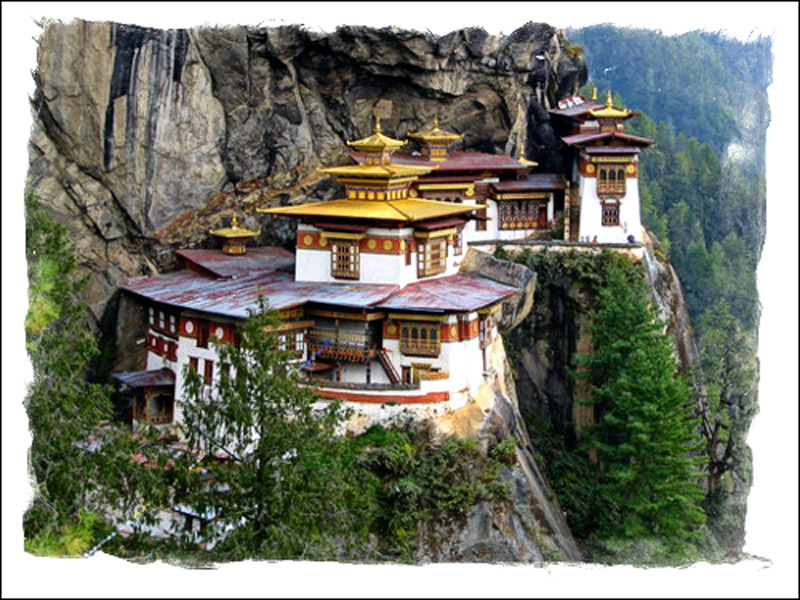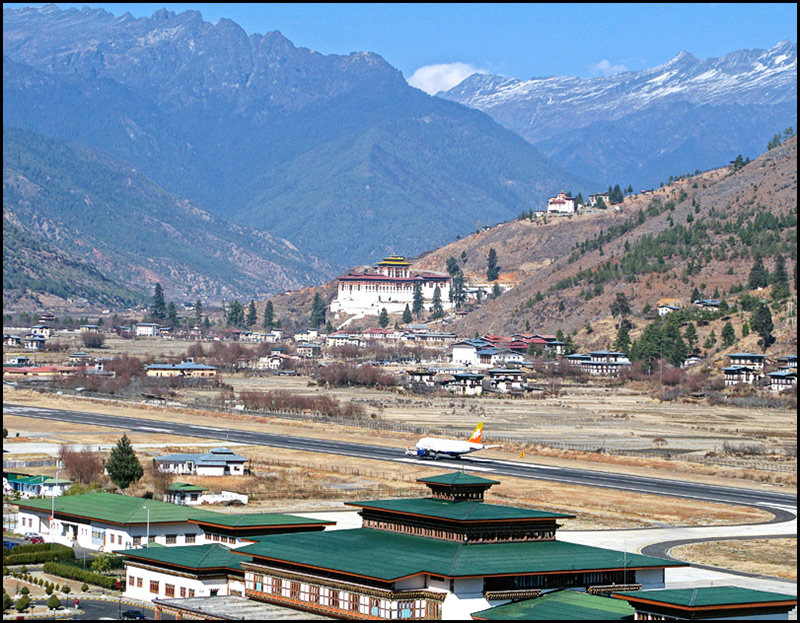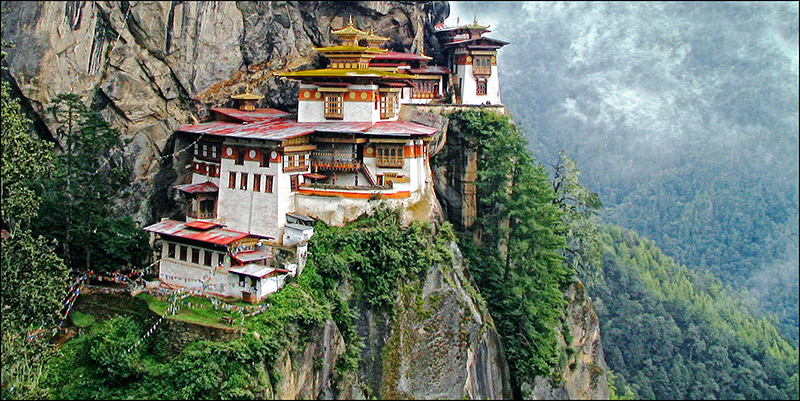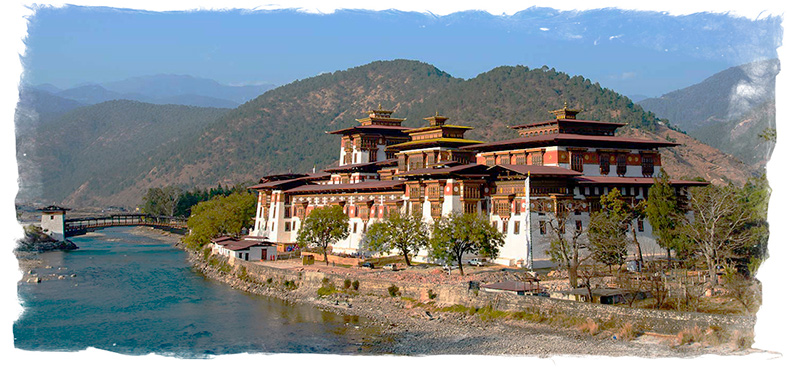Bookings are open for our PhotoSafari to Bhutan, which will be held from 15th to 21st June 2014. Please email [email protected] for costs, and to to reserve your place. We already have a few early birds for this short and very affordable photosafari to one of the most mysterious and exciting of our PhotoSafari destinations.
Our PhotoSafari to Bhutan is timed to take place just before our Muslim friends celebrate the start of Ramadan. Bhutan is just opening up to visitors. It has been a reclusive country and a land of mystery, and for a long time Bhutan allowed only very limited tourists into the country. Lately however, Bhutan is starting to welcome visitors. We will be visiting Bhutan at this early stage, when the country is still not tourist-shocked, and where the measure of an individual’s wealth is not money, but a happiness yardstick. As Bhutan is nestled in the beautiful Himalayas, you can expect Bhutan to hit you with a mixture of stunning landscapes, exotic monasteries clinging impossibly and precariously on ledges hewn out of sheer cliffs, as well as intense people interest opportunities.
Come and join us for yet another unique PhotoSafari Experience. We were in the Himalayas of Nepal in March. From 17-20th of April we will be shooting the Bromo and Ijen Volcanoes in Java. Immediately after that, from 24th April to 14th May 2014, we’ll be going to Ethiopia. Our PhotoSafari to Bhutan is slotted for 15-21st June 2014, about a month after we return from Ethiopia. After Ethiopia we have arranged additional PhotoSafaris to Cambodia, to Laos, to Xinjiang Uyghur, to Cuba and then to Morocco. Where will you have your next PhotoSafari Experience ? Difficult decisions, because each of our PhotoSafaris are unique and different.
Above is the amazing Taktsang Monastery or Tiger’s Nest, the most famous temple in Bhutan. Taktsang is located on a sheer cliff 2,700 m above the Paro Valley. The Bhutanese believe that the great Buddhist saint and teacher Padmasambhva, who brought Buddhism to Bhutan, landed at this spot, after flying over the Himalayas from Tibet, on the back of a Tigress, This is why this monastery is called the Tiger’s Nest. The main temple was built around Padmasambhava’s meditation cave in 1684. We will visit Taktsang Monastery on the second day of our PhotoSafari to Bhutan. As we will not be allowed to use the resident flying tiger, the only way to get to the Tiger’s Nest, is to hike two hours uphill, or ride a rented horse
Here is our detailed itinerary for Bhutan. Alternately, you can download an information pack by clicking the image below. For additional information or questions, please send an email to [email protected], or text Maxby at +6012-2181396
Day 1: Sunday, June 15: Singapore – Paro KB501 06:30/10:40
Fly into the country’s only airport, in the beautiful Paro valley by Drukair from Singapore. The crisp and clear mountain air, forested ridges, imposing monasteries and welcoming Bhutanese people in their striking national dress, provides you with a breath-taking first impression.
On arrival at Paro airport, after immigration and custom formalities, our Bhutanese host will receive you and transfer you to the hotel. Paro is one of the most beautiful valleys in Bhutan with its slate-roofed farmhouses, graceful willow trees, and rushing glacial river beneath snow-covered peaks. Below is a view of Paro Airport.
On our way from the airport to the hotel, we will stop at the Sunday Market in Paro to have our first photo ops in Bhutan. We will mingle with the local people and take away unique shots of this interesting local activity.It’s a small place with relatively a small crowd too but so lively.
In the afternoon, we will visit Rinpung Dzong – the 17th century massive fort. While photography within the temples in the Dzong is not allowed, there are numerous photo opportunities of the exterior and the valleys below. This excursion is meant to familiarize you with the history of this amazing kingdom in the clouds.
We can walk down to the town and a walk along the Pa Chu (River) to take pictures of the Dzong and the watchtower above. Here we will have photo ops of the covered foot bridge over the river, the huge wooden gate leading to the bridge, and the interior of the Dzong. Built in 1645, this massive building now houses the District Administration Office and the Monk Body. A flagstone path leads to the Dzong, rising gradually from the bridge that is abutted by two guard houses. The central tower, called the “Utse” of the Dzong, is clad in superb woodwork and is considered to be the nation’s most beautiful tower. The picture on the next page is Rinpung Dzong, beautifully nestled in the Paro Valley.
We can also visit the Paro archery ground where there is always activity on Sunday, usually a formal match.
Later, we will stroll along the main street in Paro. It is fascinating to watch local people, wearing their traditional dress and going about their business in a typically unhurried Bhutanese way. To have more photo ops and to have insight into the Bhutanese rural lives, we will walk through the farms and villages near by our hotel.
Altitude at Paro is 2300m. Overnight – Tenzinling Resort in Paro or similar
Day 2: Monday, June 16: Hike to Tiger’s Nest.
We will get an early start to Tiger’s Nest to avoid the hot sun and any other tourists that may be there. The morning is spent hiking (or riding horses part way – you decide) up a forested path to the Taktsang Monastery, also known as Tiger’s Nest, Bhutan’s most famous and scenic icon. The climb is steep and takes about 2 hours to ascend comfortably, but those who want to, can ride a Himalayan “bony pony” up (but not down). An important place of pilgrimage and refuge for more than 1200 years, Taktsang Monastery clings to sheer cliffs two-thousand feet above Paro Valley, and from the most popular vantage points on rocky ledges directly across a gorge from it,we will still need a 200 mm lens and a steady tripod to get tight photographs.
Next photo is the Tiger’s Nest.
After visiting what is known as one of the most venerated pilgrimage sites in Bhutan, we will go off the beaten track further up to the temples that are on the hill tops above the Tiger’s Nest. It’s so peaceful there and you can really communicate with nature as you enjoy the views from the top, be it of mountains or the valley below. No wonder some monks chose this place to meditate for the rest of their lives. They say heaven is a place on earth – perhaps this is one such place. Anyway it is as close as you can get to heaven in a day!
Coming back, we will follow a different path that takes us through the pristine thick forest of oaks and rhododendrons festooned with Spanish mosses.
After dinner those who wish to relax in Bhutan’s version of the hot tub in our hotel may do so. The two-person tubs are long and made of wood – they have three of them. A board with holes at one end separates the bather from the hot stones. With long steel tongs the attendant picks red-hot rocks from the bonfire and drops them into this chamber causing a cauldron of boiling water. The heated water then courses through the holes in the board at your feet and the water around your body heats up until you tell the attendant, “No More Rocks!” You will also enjoy the fragrant herbs that are dropped into the tub, including mint and marijuana – yes, it grows wild in Bhutan and is normally used for pig food.
Approximate walking time – 05 hours.
Altitude at Paro – 2300m. Overnight – Tenzinling Resort in Paro or similar
Day 3: Tuesday, June 17: Chele La Ridge Hike
This morning, we will take a drive to Chele La (3750m), the highest motorable pass in Bhutan and we will hike up along the meadow to Kung Karpo La (4100m). Weather permitting; we will enjoy breath-taking views of the snow-capped Himalayan Mountains while walking above the tree line along the ridge that divides Paro and Ha valley. The short steep descent from the top will take us to the nunnery of Kila Gompa. Here the nuns, called Anims, live a life of contemplation and seclusion, with daily prayers and spiritual practice. The temple itself is surrounded by numerous meditation huts, and many hidden caves lie inside the rocky cliffs. The Gompa is surrounded by a lush forest dominated by tall firs. Sparkling mountain streams wind down the slopes, which are covered with a variety of wildflowers and plants.
About 30 Anims, or nuns, live here, ranging in age from about 20 to 80 years. The community is one of the oldest of seven nunneries in Bhutan, and was initially established in the early 9th century as a meditation site. After being destroyed by fire, the temple was rebuilt and officially established in 1986 as an Anim Dratshang (religious community of Buddhist nuns).
Kila Gompa is historically significant as a sacred meditation site. Many renowned Buddhist saints have come here to find peace and seclusion. The main temple houses ancient statues of Chenrezig (Avalokiteswara) and Guru Rinpoche (Padmasambhava) among others.
Life here is simple. The day begins and ends with prayers. The Anims arise at 3 AM and study Buddhist scripture until 8 AM when they go to the temple for prayers. The first simple meal of the day (rice, vegetables and tea) is eaten at 10 AM, after which studies continue until 9 PM when a simple supper is served. The nuns retire after a final session of prayer. Most of the nuns have given up properties and left their families to live with the bare minimum of material things. Their studies and subsistence are supported by the government.
Some of the older nuns have retired into meditation, while many of the younger ones pursue basic Buddhist studies and perform religious ceremonies. The course takes 5-6 years, after which they begin meditation, which can range from four months to three years. One young nun, when asked why she had chosen this life,replied “There is peace in thinking about others, apart from you.” Another said “If I was given back my youth, I would still choose this life but I would start it earlier. I have never been more at peace with myself.”
The walk down from here to the road is lined with small white chortens and it will take us about an hour.
Approximate walking time – 05 hours. Altitude at Paro – 2300m.
Overnight – Tenzinling Resort in Paro or similar.
Day 4: Wednesday, June 18: Paro – Thimphu
Drive to Thimphu which would be perhaps the most unusual capital city in the world is the seat of government, home to Bhutan’s royal family, the civil service, and foreign missions with representation in Bhutan. It is also the headquarters for a number of internationally funded development projects.
What to see in Thimphu
Buddha Dordenma Statue
This massive statue of Shakyamuni measures in at a height of 51.5 meters, making it one of the largest statues of Buddha in the world. The statue is made of bronze and is gilded in gold. 125,000 smaller Buddha statues have been placed within the Buddha Dordenma statue, 100,000 8 inch tall and 25,000 12 inch tall statues respectively. Each of these thousands of Buddhas has also been cast in bronze and gilded. The throne that the Buddha Dordenma sits upon is a large meditation hall.
The Buddha Dordenma is located atop a hill in Kuenselphodrang Nature Park and overlooks the Southern entrance to Thimphu Valley.The statue fulfils an ancient rophecy dating back to the 8th century A.D that was discovered by Terton Pema Lingpa (Religious Treasure Discoverer) and is said to emanate an aura of peace and happiness to the entire world.
Motithang Takin Preserve
A short distance up the road to the telecom tower is a trail leading to a large fenced area that was originally established as a mini-zoo. The king decided that such a facility was not in keeping with Bhutan’s environmental and religious convictions, and it was disbanded some time ago.
The animals were released into the wild but the takins, Bhutan’s national animal, were so tame that they wandered around the streets of Thimphu looking for food, and the only solution was to put them back into captivity. It’s worthwhile taking the time to see these oddball mammals. The best time to see them is early morning when they gather near the fence to feed. It’s a five-minute walk from the road to a viewing area where you can take advantage of a few holes in the fence to take photographs.
Tashichhodzong
The “fortress of the glorious religion” was initially erected in 1641 and rebuilt by King Jigme Dorji Wangchuk in the 1960s. While other governments around the world ensconce themselves in fortresses of stone and steel, the seat of Bhutan’s Royal Government is in a building that mirrors the country’s culture and its people.
The building we see today is largely a modern building, built in 1962 when His Majesty Jigme Dorji Wangchuk moved the government to Thimphu after a fire at its original location. The complex’s central tower is original. Tashichhodzong houses the main secretariat building, and the throne room of His Majesty the King of Bhutan. During the warmer summer months the monk body headed by His Holiness, the Je Khenpo, makes its home in the Dzong.
Approximate driving time – 01 hour. Altitude at Thimphu – 2400m
Overnight – Jomolhari Hotel in Thimphu or similar
Day 5: Thursday, June 19: Thimphu – Punakha
Arise at 0700 (if you wish) and go to the Memorial Chorten, built in 1974 in memory of the third king, His Majesty Jigme Dorji Wangchuck, who died in 1972. Local residents flock here in the morning to chant their daily prayers as they walk clockwise around the chorten (temple), spinning prayer wheels as they pass fragrant columns of smoke from smoldering juniper branches that carry a stream of prayers to the mountain deities. Bring a tripod and shoot with high ISO because sunlight doesn’t hit here until late morning.
After breakfast, we then begin our drive to Punakha, en route stopping at the 10,500 ft. Dochu La pass for tea and biscuits and enjoy our first view of the eastern Himalayan Mountains. Here we can spend some time photographing the Druk Wangyal Chortens. Built in 2004 to “…celebrate the stability and progress that His Majesty has brought to the nation,” this hill of 108 religious buildings in the middle of the pass reflects Bhutan’s spiritual and artistic traditions. Then it’s on to Punakha where the most prominent feature is the Punakha Dzong where we can photograph the colorful exterior, new covered Foot Bridge, and interior courtyards with colorful and intricately painted doorways and temple exteriors. Built in 1637 between the confluence of the Po Chu (Male River) and Mo Chu (Female River,) this fortress monastery is the winter residence of Bhutan’s spiritual leader, the Je Khenpo or Head Abbot, and the central Monk Body -350 monks in total.
Later, we will take a drive to Talo – the native home town of the queens for our short downhill hike following the beautiful track that links the village of Talo and Nobgang where we will see the villages and the village folks.
Approximate driving time – 03 hours. Altitude at Punakha – 1300m
Overnight – Hotel Lobeysa in Punakha or similar.
Day 6: Friday, June 20: Punakha – Paro.
This is our last full day in Bhutan and we spend it mostly driving back to Paro. Along the way we will make plenty of roadside stops for photos, lunch and tea/coffee.
Tonight, we will have farewell dinner at our hotel with a cultural programme. It will be a recreation of the festival on a smaller scale. The events will roll on for a couple of hours with breaks for rest, festive drinking and eating, and posing for photographs. We will not be seeing the event merely as spectators but participating actively in the festivities – dancing, singing and drinking, etc. The idea is for guests not only to see the cultural performances as such but to experience a crash course in a part of Bhutanese culture.
Approximate driving time – 04 hours. Altitude at Paro – 2300m
Overnight – Tenzinling Resort in Paro or similar
Day 7: Saturday, June 21: Paro – Singapore KB 500 07:20/15:30
After breakfast in the hotel, drive to the airport in time to catch our onward flight home. We will say farewell to our gracious hosts, and as we fly out of Paro Airport, the remote and legendary Dragon Kingdom will disappear from view again behind its guardian mountains.














